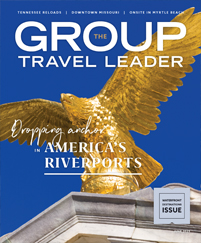Picture this: You get back from an amazing trip and begin scrolling through your photos, only to find they are lackluster. Maybe they’re blurry, too dark or simply look like every other photo of that destination you’ve seen. So how do you take better travel photos?
Despite the amazing photography capabilities of the technology in our pockets, many people end up asking themselves this question. It’s especially important to take good travel photos if you’re planning to use them to promote upcoming group trips, grow your business or gain visibility on social media platforms.
Here are some quick and easy tips for improving your travel photography.
Tip 1: Rotate Your Phone
Most people’s instinct is to take pictures the same way they hold their phones: vertically. But most often, horizontal photos will allow you to capture more of what you’re trying to capture and less unused space, such as the sky or the ceiling. So, the first step to taking better travel photos is to hold your phone horizontally instead of vertically. Horizontal photos are also better to feature online in promotional website content. Note that there are exceptions to this rule, such as when you’re trying to photograph something exceptionally tall, taking someone’s portrait or shooting a vertical video for a platform like TikTok.
Tip 2: Stop Zooming In
You’ll notice that when you zoom in on most smart phone cameras, the image quickly grows blurry and pixelated. That’s because smartphone camera lenses often have a fixed focal length; in other words, they can’t really magnify the image for a true optical zoom the way traditional camera lenses can. They merely make one part of the image bigger on your screen. You can achieve the same effect by cropping the image afterward. Newer smartphones with multiple lenses may enable you to employ a true optical zoom, but these can only take you so far. So, if you want to zoom in on an object, don’t pinch your screen—get closer.
Tip 3: Use The Rule of Thirds
If you’re familiar with photography, you may have heard the “rule of thirds,” which boils down to this: The eye is drawn to what’s in the right or left third of an image rather than what is in the center of it. Placing the subject of your photo on the “thirds” of the image rather than in the center makes a more aesthetically pleasing image. If you have trouble visualizing this, there’s a grid function on most smartphone cameras that creates a grid on your screen to help you compose your shot and create better travel photos.
Tip 4: Learn How to Adjust Exposure and Focus
Did you know you can brighten an image before you take the photo? You can also lock the focus into place. On an iPhone, simply tap and hold on the screen on the object of your photo until a little yellow box appears around it and the words “AE/AF LOCK” appear at the top. Now the focus is locked on the object of the photo. You’ll also see a little sun symbol next to the yellow box. Simply drag up or down on the screen near the sun symbol to brighten or darken the photo. To “unlock” the image’s focus and brightness, tap anywhere on the screen. The function is similar for Android users, tap and hold on the object and a circle showing the object your phone camera is locked onto will appear with a slider underneath. You can slide the sun symbol left or right to adjust the brightness. This function is useful if your camera is having trouble focusing on the desired object or if lighting is an issue.
Tip 5: Make People the Focal Point
If you’re taking travel photos, it’s tempting to fill your camera roll with landscapes. That’s instinct. When you see the ocean, a meadow full of flowers or any other beautiful natural scenery, of course, you want to take a picture of it! But when it comes to better travel photos, some of the most enticing shots have human subjects. That’s because humans help photos tell a story, and they’re easier for us to relate to. Besides, photos with people in them often depict exciting activities or excursions at a destination. If you want to draw people in with your photography, look for people to photograph (with their permission, of course). So go ahead and take pictures of the scenery, just don’t forget about the people.
More Ideas for Taking Better Travel Photos
Want more tips for taking better travel photos? Check out our podcast episode on this topic with travel photographer and blogger Stephanie Miller.











